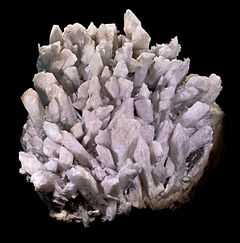Danburite
From Wikipedia, the free encyclopedia
| Danburite | |
|---|---|
 Danburite 35x28x21cm | |
| General | |
| Category | Tectosilicates |
| Formula (repeating unit) | CaB2(SiO4)2 |
| Identification | |
| Color | Colorless, White, Gray, Brownish white, Straw yellow |
| Crystal system | Orthorhombic |
| Cleavage | {001} Poor |
| Fracture | Subconchoidal |
| Mohs scale hardness | 7 - 7.5 |
| Luster | Vitreous - Greasy |
| Streak | White |
| Diaphaneity | Transparent to translucent |
| Specific gravity | 3.0 |
| Ultraviolet fluorescence | Fluorescent and thermoluminescent (red), Short UV=violet blue, Long UV=blue to blue-green |
| References | 1 |
Danburite is a crystalline mineral similar to topaz.
Its chemical formula is CaB2(SiO4)2. It has a Mohs hardness of 7 to 7.5 and a specific gravity of 3.0. The mineral has an orthorhombic crystal form. It is usually colourless, like quartz, but can be also either pale yellow, yellowish-brown, or pink. It typically occurs in contact metamorphic rocks.
It is named for Danbury, Connecticut, United States where it was first discovered in 1839 by Charles Upham Shephard.

Danburite from Mexico, ~ 4 cm in height
References
| Wikimedia Commons has media related to Danburite. |
This article is issued from Wikipedia. The text is available under the Creative Commons Attribution/Share Alike; additional terms may apply for the media files.